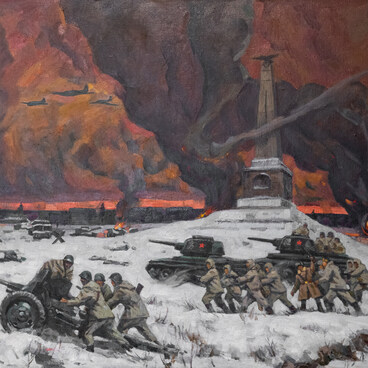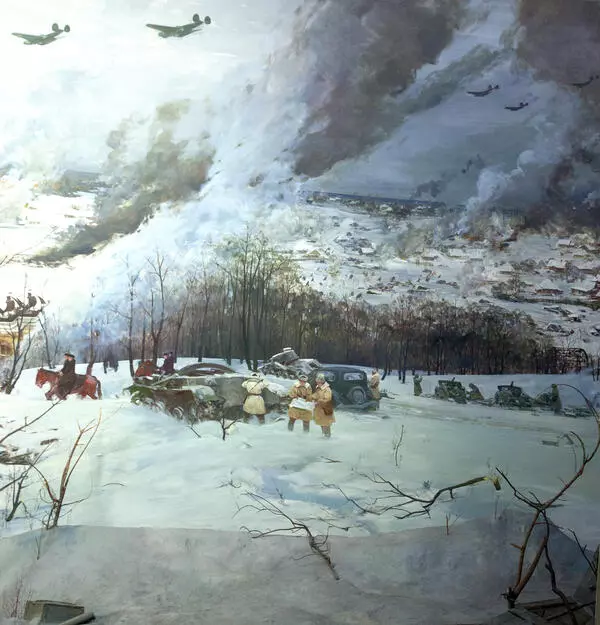November 7, 1941 was a very significant day in the history of the Soviet Union. On that day, a historic Red Army parade was organized on the main square of the country. The exhibition of the Victory Museum houses a painting by the talented military artist Yevgeny Danilevsky. The painter is known for his monumental works created for VDNKh and the Grekov Studio of Military Art.
In the fall of 1941, when the German forces were getting closer and closer to the Soviet capital, it was important to dispel any rumors and raise the spirits of people. In order to do that, Joseph Stalin ordered to organize a parade in honor of the 24th anniversary of the October Revolution. The event was prepared in strict secrecy. It was extremely risky because German air forces could try to attack Moscow to kill the senior leadership of the Soviet Union. However, meteorological observers reported that the day would be snowy, and the weather would be unsuitable for flying. On the night before the parade, Lenin’s Mausoleum was uncloaked, and the Kremlin’s red stars were uncovered and illuminated. The parade was inspected by Marshal Semyon Budyonny. Having already organized numerous parades and being well-versed in military music, Budyonny himself chose four musical pieces among the ones suggested by composer Vasily Agapkin. These included Agapkin’s famous march “Farewell of Slavianka” that was performed twice — at the beginning and at the end of the parade.
In order to ensure security, the parade was scheduled to start at 8 a.m. and not at 10 a.m. as in peacetime. Joseph Stalin and other government officials appeared on the mausoleum stand ten minutes before the beginning of the parade. Over twenty thousand military servicemen marched across Red Square. In total, the parade brought together around 28.5 thousand people, 16 machine-gun carriers, 140 pieces of artillery, 160 tanks, and 232 motor vehicles.
On November 6 and 7, 1941, the Soviet forces planned and organized several powerful attacks at Mozhaisk, Volokolamsk, and Maloyaroslavets. Red Army troops went to battle immediately after the parade.
The importance of the event cannot be overemphasized. Soviet frontline soldiers and workers of the home front were inspired by the parade and considered it to be a sign of sure victory. People across the country listened to Stalin’s legendary speech over the radio.
In the fall of 1941, when the German forces were getting closer and closer to the Soviet capital, it was important to dispel any rumors and raise the spirits of people. In order to do that, Joseph Stalin ordered to organize a parade in honor of the 24th anniversary of the October Revolution. The event was prepared in strict secrecy. It was extremely risky because German air forces could try to attack Moscow to kill the senior leadership of the Soviet Union. However, meteorological observers reported that the day would be snowy, and the weather would be unsuitable for flying. On the night before the parade, Lenin’s Mausoleum was uncloaked, and the Kremlin’s red stars were uncovered and illuminated. The parade was inspected by Marshal Semyon Budyonny. Having already organized numerous parades and being well-versed in military music, Budyonny himself chose four musical pieces among the ones suggested by composer Vasily Agapkin. These included Agapkin’s famous march “Farewell of Slavianka” that was performed twice — at the beginning and at the end of the parade.
In order to ensure security, the parade was scheduled to start at 8 a.m. and not at 10 a.m. as in peacetime. Joseph Stalin and other government officials appeared on the mausoleum stand ten minutes before the beginning of the parade. Over twenty thousand military servicemen marched across Red Square. In total, the parade brought together around 28.5 thousand people, 16 machine-gun carriers, 140 pieces of artillery, 160 tanks, and 232 motor vehicles.
On November 6 and 7, 1941, the Soviet forces planned and organized several powerful attacks at Mozhaisk, Volokolamsk, and Maloyaroslavets. Red Army troops went to battle immediately after the parade.
The importance of the event cannot be overemphasized. Soviet frontline soldiers and workers of the home front were inspired by the parade and considered it to be a sign of sure victory. People across the country listened to Stalin’s legendary speech over the radio.






